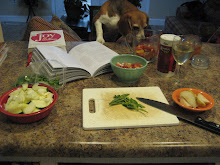But I've given it up.
In one fell swoop, I stopped eating fast food after the first few pages of "The Omnivore's Dilemma." I've also stopped drinking soda--I haven't touched one in about a month. This Southern gal has even foregone the sweet tea. The result? I feel 10 times better about myself, and I've lost close to 10 pounds in that month. I'm more energetic. But the funny thing? I didn't accomplish any of that by starving myself. I just made a conscious decision to try to get off the Western diet (that is, one of processed foods and large, fatty portions) as much as I could. I eat less. I pay attention to when I'm actually full, which happens (as it turns out) well before I finish everything on my plate. I've started cooking more with whole, local foods.
Which leads me to this post: I decided over the weekend to endeavor to make a dinner using local foods to the extent possible. The dinner? I decided on spaghetti with meatballs. That meant the meatballs included only local, grass-fed and grass-finished beef (from Shadowchase Farm, a farm committed to producing grass-fed and grass-finished beef; we've since decided to order a family pack from them to stock our freezer), the sauce was homemade using ingredients that came without a bar code, and the spaghetti would be made from scratch.
Fortunately, I will say I have loved to cook since I was young. To me, cooking is therapy and probably speaks more to my obsessive compulsive desire to control things. But I love it. To me, this dinner was something I looked forward to making all week long. On morning runs, I would think about the ingredients to use, how to prepare everything just right.
Of course, I was daunted by one ingredient: the homemade spaghetti. You see, I love all things dough, but never has dough returned the favor by being easy on me in terms of recipes. I'm intimidated by making bread, and the thought of having to make something that requires kneading and resting makes me nervous.
Which is probably why, no, the spaghetti didn't turn out as well as I hoped. It was edible, yes, but it wasn't a quality consistency. I went into the recipe intimidated, and it showed in the results. Was it a disaster? No, not hardly. It just means I need more practice. The recipe I used was fairly simple (except I subbed in unbleached whole wheat flour because, well, I wanted whole wheat pasta). The eggs I used were from a local produce stand that sells the eggs on behalf of a local farm. So, my intentions were good in terms of the ingredients used--I just need to approach pasta-making the next time with more confidence, a better recipe, and (ahem, if anyone is so inclined to purchase it for me) a pasta machine (no, I don't have one, so I thought I could get by with rolling the dough by hand and slicing with a knife).
 |
| See? They totally look like pasta noodles. |
I am happy to say, however, that the meatballs more than made up for the iffy pasta. Using one pound of the local beef from Shadowchase, I mixed in one egg (again, using only local eggs), about 1/2 tsp. salt, and freshly cracked pepper. I've never made meatballs before, but I've watched enough cooking shows to know that, if you want them to bind together well, it's best to use breadcrumbs in addition to the egg. I wanted to use some herbs, and I definitely didn't want to use store bought breadcrumbs, so I found the best of both worlds: a bit of leftover olive rosemary bread from a local bakery. I just sliced up the bread and popped it into a food processor to make about 1 c. of fresh breadcrumbs, tossing those in with the meat mixture. I rolled the meat into about 1.5" balls and placed them into the refrigerator to chill (I've found chilled meat works best when cooking patties or meatballs).
Meanwhile, I heated a large saute pan and about 1 tbsp. olive oil to medium-high heat and brought about 6 quarts of water to a boil in a separate pan for the pasta. I placed the chilled meatballs in the heated saute pan, cooking for about 6 minutes on each side, then turned them around the edges to brown. When finished, I removed the meatballs to a plate and tented them with aluminum foil to lock in the heat.
Overnight I had thawed some leftover homemade pasta sauce, so I poured that straight into the pan I used for the meatballs. I brought the sauce to a simmer over medium-low heat, then placed the meatballs into the sauce and covered, simmering and stirring occasionally for about 20 minutes.
It's important to note that, if you make homemade pasta, it takes much less time to boil the noodles. So, when my water came to a boil about 10 minutes before the meatballs and sauce were done, I poured in about 1 tbsp. salt and a drizzle of olive oil (to prevent the pasta from sticking together or to the pan), and boiled the pasta for about 6 minutes.
The result:
 |
| I'm sorry--there's no way for me to make spaghetti look edible in pictures. |
A side just included shredded lettuce topped with cucumbers and cherry tomatoes, both purchased from the local farmer's market.
This way of cooking is, yes, a learning curve. It's not simple, but I've learned that actual food itself isn't simple. It's a process, it takes time. But you know what? I don't miss the processed, fast food or drinks. At all.



No comments:
Post a Comment